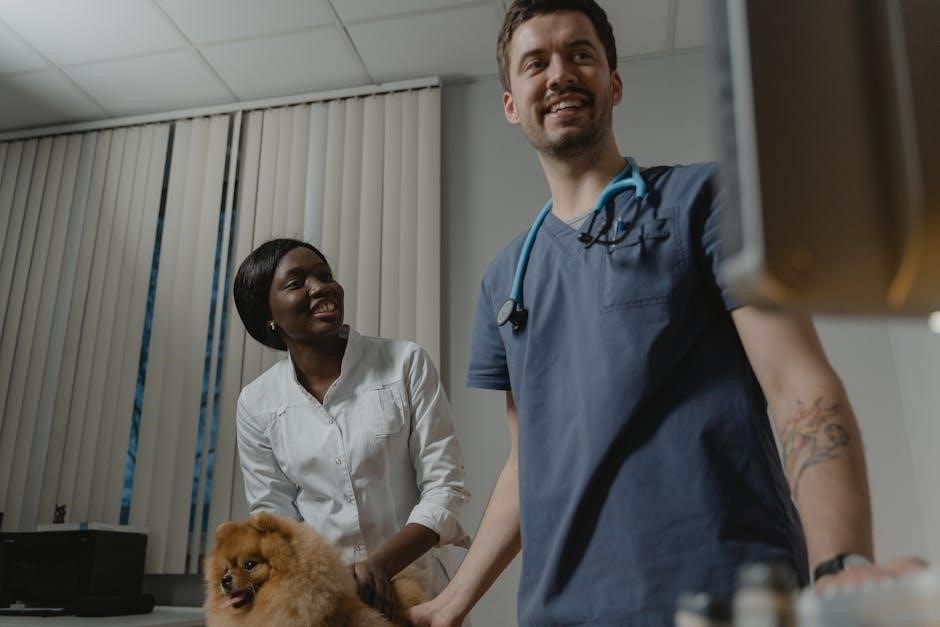Veterinary terminology is a specialized language essential for clear communication in animal healthcare. Rooted in Greek and Latin, it enables precise discussions about anatomy, diseases, and treatments. Understanding this terminology is crucial for effective patient care, client communication, and professional collaboration. Resources like PDF guides and textbooks provide comprehensive learning tools, helping students and professionals master the field.
1.1 Importance of Veterinary Terminology
Veterinary terminology is crucial for precise communication among professionals, ensuring accurate diagnoses and treatments. It provides a standardized language, enabling clear documentation and effective client interactions. Understanding these terms is essential for delivering high-quality care, as it facilitates professional collaboration and informed decision-making. Mastery of veterinary terminology is not just academic; it is vital for daily practice, enhancing efficiency and patient outcomes in all aspects of animal healthcare.
1.2 Structure and Origins of Veterinary Terms
Veterinary terms are primarily derived from Greek and Latin roots, with prefixes, suffixes, and combining forms that create precise meanings. This structured approach aligns with medical terminology, ensuring consistency and clarity. Understanding these origins aids in deciphering unfamiliar terms, making it easier to learn and apply them in practice. The foundation of veterinary terminology is essential for effective communication and accurate documentation in animal healthcare settings.
Key Resources for Learning Veterinary Terminology
Comprehensive textbooks, online glossaries, and PDF guides provide structured learning. Illustrated guides and dictionaries offer detailed explanations, while digital tools enhance understanding and practical application of veterinary terms effectively.
2.1 “An Illustrated Guide to Veterinary Medical Terminology, 4th Edition”
This comprehensive textbook uses detailed illustrations and structured content to teach veterinary medical terminology. It covers various body systems, including skeletal, muscular, and digestive, with exercises for practice. Designed for students and professionals, it provides a thorough understanding of terms, enhancing communication and patient care. The guide is a valuable resource for mastering the language of veterinary medicine effectively.
2.2 Online Glossaries and Dictionaries
Online glossaries and dictionaries provide accessible resources for understanding veterinary terminology. Websites like PetMD and the University of Illinois offer extensive lists of terms, abbreviations, and acronyms. These tools are invaluable for students and professionals, enabling quick reference and enhancing communication. They cover a wide range of topics, from basic anatomy to specialized oncology terms, making them essential for mastering veterinary language and staying updated on industry-specific vocabulary.
2.3 Veterinary Terminology PDF Guides
Veterinary terminology PDF guides offer comprehensive resources for learning and reference. Titles like “An Illustrated Guide to Veterinary Medical Terminology” provide detailed explanations, illustrations, and practice exercises. These guides cover essential topics such as anatomy, medical terms, and abbreviations. Designed for both students and professionals, they are invaluable for mastering veterinary language. Many PDFs also include specialized sections on oncology, surgical terms, and common medical abbreviations, enhancing their utility in clinical and educational settings.
Basic Components of Veterinary Terms
Veterinary terms are built using prefixes, suffixes, roots, and combining forms. These components provide clarity and precision in veterinary communication, aiding in understanding complex medical terminology effectively.
3.1 Prefixes, Suffixes, and Roots
Veterinary terms are constructed using prefixes, suffixes, and roots, often derived from Greek and Latin. Prefixes modify meaning, such as “hyper-” (excessive) or “hypo-” (deficient). Suffixes indicate conditions or procedures, like “-itis” (inflammation) or “-ectomy” (removal). Roots provide the core meaning, e.g., “cardio-” for heart or “neuro-” for nerves. Understanding these components aids in deciphering and applying veterinary terminology accurately in clinical settings.
3.2 Combining Forms and Their Meanings
Combining forms are essential in veterinary terminology, blending roots with vowels to create specific terms. For example, “arthro-” refers to joints, while “derm-” pertains to skin. These forms often combine with prefixes or suffixes to form complete terms, such as “arthritis” (joint inflammation). Understanding combining forms enhances the ability to decode and apply complex veterinary terms accurately in clinical and educational settings.
Common Veterinary Abbreviations and Acronyms
Veterinary abbreviations like DNA (deoxyribonucleic acid) and FIV (feline immunodeficiency virus) simplify communication. Acronyms such as WSAVA (World Small Animal Veterinary Association) are widely used in medical records and professional communication.
4.1 Frequently Used Abbreviations in Veterinary Practice
Common veterinary abbreviations include DNA (deoxyribonucleic acid), FIV (feline immunodeficiency virus), and PCV (packed cell volume). These shorthand terms streamline communication in medical records, prescriptions, and client discussions. For example, FeLV stands for feline leukemia virus, while URI denotes upper respiratory infection. Mastery of these abbreviations enhances efficiency and clarity in daily practice, ensuring accurate documentation and effective care delivery.
4.2 Acronyms in Veterinary Medicine
Acronyms like WSAVA (World Small Animal Veterinary Association) and WOW (WSAVA Oncology Working Group) are integral to veterinary communication. These shorthand terms simplify complex concepts, aiding in efficient documentation and discussions. For instance, PCR (polymerase chain reaction) and MRI (magnetic resonance imaging) are commonly used in diagnostics. Acronyms enhance clarity and speed in clinical settings, ensuring precise understanding among professionals and effective patient care delivery.

Anatomy and Physiology Basics
Understanding essential anatomical terms and physiological processes is fundamental to veterinary terminology. These basics provide the foundation for comprehending animal health, diseases, and treatments effectively.
5.1 Essential Anatomical Terms
Essential anatomical terms form the cornerstone of veterinary terminology, describing body structures and their relationships. Terms like abdomen, artery, and conjunctiva are vital for understanding animal anatomy. These terms, often derived from Latin and Greek roots, help professionals communicate accurately. Resources like “An Illustrated Guide to Veterinary Medical Terminology” provide detailed illustrations and exercises to master these concepts, ensuring a strong foundation for diagnosing and treating conditions across various species.
5.2 Physiological Processes and Related Terminology
Physiological processes in veterinary terminology describe how body systems function, such as digestion, circulation, and respiration. Terms like deoxyribonucleic acid (DNA) and anemia are crucial for understanding health and disease. These processes are detailed in resources like “An Illustrated Guide to Veterinary Medical Terminology,” which covers body systems and their functions. Mastering these terms aids in diagnosing conditions, ensuring accurate communication and effective treatment plans for animals.

Body Systems and Their Terminology
Veterinary terminology categorizes body systems like skeletal, muscular, digestive, and respiratory. Each system has specific terms describing its structure and function, aiding in accurate diagnoses and treatments.
6.1 Skeletal and Muscular Systems
The skeletal system includes terms like bones, joints, and cartilage, while the muscular system covers muscles, tendons, and ligaments. These terms are vital for understanding anatomy and physiology, enabling accurate diagnoses and treatments in veterinary practice. Resources like PDF guides provide detailed illustrations and definitions, helping professionals master the terminology related to movement, support, and common conditions affecting these systems in animals.
6.2 Digestive and Respiratory Systems
The digestive system involves terms like abdomen, intestines, and digestive enzymes, while the respiratory system includes trachea, bronchi, and alveoli. These systems are crucial for nutrient absorption and oxygen exchange. Veterinary terminology PDF guides provide detailed explanations and illustrations, helping professionals understand conditions like gastroenteritis and pneumonia. Mastering these terms is essential for accurate diagnoses and effective treatments in animal care.
6.3 Cardiovascular and Nervous Systems
The cardiovascular system includes terms like arteries, veins, and cardiac cycle, while the nervous system involves neurons, synapses, and central nervous system. Veterinary terminology PDF guides detail these systems, explaining functions and conditions like myocardium and peripheral nervous system. These resources provide clear illustrations and definitions, aiding professionals in diagnosing and treating cardiovascular and neurological disorders in animals effectively.

Common Veterinary Medical Terms
Common terms include abdomen, anesthesia, DNA, anemia, and artery. These terms are essential for understanding animal health, diagnostics, and treatments, as detailed in veterinary terminology PDF guides.
7.1 Terms Related to Diagnosis and Treatment
Key terms include anemia (low red blood cell count), fistulous withers (infected tissue in horses), and flagellate (single-celled organisms). These terms aid in diagnosing conditions and guiding treatments, such as surgery or medication, ensuring accurate patient care and effective communication among professionals, as detailed in veterinary terminology PDF resources.
7.2 Terms for Surgical and Dental Procedures
Terms like fistulous withers (infected tissue in horses) and flagellate (single-celled organisms) are crucial in surgical contexts. Dental procedures involve terms like extractions or orthopedic surgeries. These terms guide precise surgical interventions, ensuring accurate communication and effective treatment planning, as outlined in veterinary terminology PDF guides, aiding professionals in delivering specialized care.

Specialized Terminology in Veterinary Oncology
The World Small Animal Veterinary Association (WSAVA) provides a glossary of oncology terms, aiding understanding of cancer-related terminology like chemotherapy and metastasis in veterinary care.
8.1 Glossary of Veterinary Oncology Terms
The World Small Animal Veterinary Association (WSAVA) Oncology Working Group offers a glossary of veterinary oncology terms, clarifying complex concepts like chemotherapy and metastasis. This resource aids pet owners and professionals in understanding cancer-related terminology. A dedicated veterinary terminology PDF guide focuses on companion animals, detailing terms specific to canine and feline oncology, ensuring accurate communication and care in veterinary practice.
8.2 Understanding Cancer-Related Terminology
Understanding cancer-related terminology is vital for effective communication in veterinary oncology. Terms like chemotherapy, metastasis, and remission are essential for discussing treatment options and prognoses. The World Small Animal Veterinary Association (WSAVA) provides a glossary of oncology terms, aiding professionals and pet owners in comprehending complex concepts. These resources, often available as veterinary terminology PDF guides, ensure accurate understanding and application in clinical practice.

First Aid and Emergency Care Terminology
First aid and emergency care terminology includes terms like triage, stabilization, and wound management. These terms are critical for providing immediate care and communicating effectively in urgent situations.
9.1 Emergency Medical Terms
Emergency medical terms in veterinary care include triage, stabilization, and wound management. These terms are vital for assessing conditions, providing immediate care, and communicating effectively in urgent situations. Understanding terms like cardiac arrest, respiratory distress, and shock is crucial for prompt intervention. They guide professionals in prioritizing treatments and ensuring the best outcomes for animals in critical conditions, making them indispensable in emergency veterinary practice.
9.2 Terms for Wound Care and Infections
Key terms in veterinary wound care include debridement, abscess, and necrosis. Infections are often described using terms like fistula, sepsis, and antimicrobial. Understanding these terms aids in diagnosing and treating wounds effectively. Techniques like hydrotherapy and granulation are essential for healing. Accurate terminology ensures proper documentation and communication, critical for effective wound management and infection control in veterinary practice.
Veterinary Terminology in Practice
Veterinary terminology is crucial for effective communication and documentation in clinical settings. It aids in client interactions, accurate record-keeping, and precise treatment plans, ensuring clear understanding among professionals.
10.1 Communication with Clients
Effective client communication relies heavily on clear veterinary terminology. Accurate use of terms ensures clients understand diagnoses, treatments, and care instructions. This clarity helps build trust and avoids misunderstandings, fostering better pet care outcomes. Veterinary professionals must balance technical language with approachable explanations, making complex concepts accessible. Proper terminology usage is vital for relaying information about procedures, medications, and prognoses, ensuring clients are well-informed and engaged in their pets’ health decisions.
10.2 Documentation and Record-Keeping
Accurate veterinary terminology is crucial for effective documentation and record-keeping. Clear and precise language ensures patient records are comprehensive and easily understood by all stakeholders. Proper use of terms prevents errors and ensures consistency in medical notes, treatment plans, and client communications. Well-maintained records are essential for legal purposes, continuity of care, and future reference, making veterinary terminology a cornerstone of professional practice and patient management.

Learning and Mastering Veterinary Terminology
Mastering veterinary terminology requires consistent practice and dedication. Utilize textbooks, online guides, and PDF resources to build a strong foundation. Clear communication and accurate documentation are key outcomes of proficiency in this specialized language.
11.1 Tips for Students and Professionals
Students and professionals should utilize textbooks like An Illustrated Guide to Veterinary Medical Terminology and online PDF resources for structured learning. Focus on understanding prefixes, suffixes, and roots to decode terms. Practice with exercises and case studies to reinforce knowledge. Regularly review glossaries and stay updated on new terminology. Consistent practice and application in real-world scenarios will enhance proficiency and confidence in using veterinary terminology effectively.
11.2 Common Mistakes to Avoid
Common mistakes include misinterpreting prefixes, suffixes, and roots, leading to incorrect term meanings. Neglecting anatomy and physiology basics can hinder understanding. Overlooking practice exercises and relying solely on memorization is another pitfall. Additionally, ignoring updates in terminology and failing to cross-reference with reliable resources can lead to inaccuracies. Avoiding these errors ensures a stronger foundation in veterinary terminology and its practical application.
Case Studies in Veterinary Terminology
Case studies provide practical examples of veterinary terminology in real-world scenarios, helping professionals understand complex conditions and treatments through detailed, illustrated applications of medical terms.
12.1 Practical Applications of Terminology
Case studies in veterinary terminology demonstrate real-world applications, such as diagnosing conditions like fistulous withers or flagellate infections. These examples illustrate how terms are used in practice, aiding professionals in understanding complex medical scenarios. Illustrated guides and PDF resources provide detailed exercises and scenarios, enhancing learning and application of terminology in diagnosing, treating, and communicating effectively in veterinary care.
12.2 Real-World Examples and Scenarios
Real-world scenarios, such as diagnosing a horse with fistulous withers or identifying flagellate organisms, highlight the practical use of veterinary terminology. These examples, often detailed in PDF guides, demonstrate how terms like “anemia” or “arthritis” are applied in clinical settings. Such scenarios help professionals understand and communicate complex conditions effectively, ensuring accurate diagnoses and treatments for animals.

The Future of Veterinary Terminology
The future of veterinary terminology lies in digital tools and online resources, enhancing accessibility and understanding. Advances in technology will streamline learning and application in clinical settings.
13.1 Advances in Veterinary Medical Language
Advances in veterinary medical language are driven by digital tools and updated resources. Online glossaries, interactive PDF guides, and AI-powered platforms enhance learning and accessibility. These innovations ensure terminology stays current, reflecting new discoveries and practices. Integration of multimedia, such as videos and 3D models, improves understanding. Regular updates to veterinary terminology PDFs keep professionals informed, fostering precise communication and advancing animal care.
13.2 Digital Tools for Terminology Learning
Digital tools revolutionize veterinary terminology learning through interactive platforms and mobile apps. PDF guides with clickable terms, online glossaries, and spaced repetition software enhance retention. Virtual flashcards and 3D anatomy models provide immersive learning experiences. These tools offer flexibility, allowing students to study anytime, anywhere. Regular updates ensure terminology stays current, making digital resources indispensable for mastering veterinary medical language efficiently.

Conclusion
Veterinary terminology is vital for effective communication in animal healthcare. Resources like PDF guides and online tools provide comprehensive learning aids, ensuring mastery of essential terms and concepts.
14.1 Summary of Key Points
Veterinary terminology is a foundational language for animal healthcare, enabling precise communication. Key components include prefixes, suffixes, and roots, which form complex terms. Resources like PDF guides and textbooks offer structured learning, covering anatomy, body systems, and specialized fields. Mastery of this terminology enhances clinical practice, client interactions, and professional collaboration, ensuring accurate documentation and effective care.
14.2 Final Thoughts on the Importance of Veterinary Terminology
Veterinary terminology is vital for clear communication, accurate diagnoses, and effective treatment. It bridges understanding between professionals, clients, and patients, ensuring precise care. Mastery of this language enhances professionalism, reduces errors, and improves patient outcomes. Continuous learning and adaptation to new terms are essential, as the field evolves. Proper use of terminology fosters trust and collaboration, making it indispensable in veterinary practice and education.

References and Further Reading
Key textbooks like “An Illustrated Guide to Veterinary Medical Terminology” and online glossaries from PetMD and Merck Veterinary Manual offer comprehensive resources for further learning and reference.
15.1 Recommended Textbooks and Guides
15.2 Online Resources and Communities
Online resources like PetMD’s Veterinary Medical Terms and the University of Illinois’s Veterinary Abbreviations provide accessible learning tools. The World Small Animal Veterinary Association offers a glossary for oncology terms. Scribd hosts PDF guides, such as “An Illustrated Guide to Veterinary Medical Terminology, 4th Edition,” for comprehensive study. These digital platforms support continuous learning and professional development in veterinary terminology.